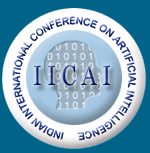

The scope of the conference includes all areas of AI and related technologies. Sample areas include, but certainly not limited to the following:
Adaptive Systems
Agent-Based Systems
AI and Creativity
Artificial Life
Automated Problem Solving
Behavioral Neuroscience
Brain Models
Case Based Reasoning
Cognitive Modeling
Computational Neuro Science
Computer Vision
Constraint Satisfaction Problems
Content Based Image Retrieval
Data mining
Decision Support Systems
Distributed AI
Emerging Applications
Evaluation of AI Systems
Evolutionary Computation
Evolutionary Algorithms
Expert Systems
Foundations of AI
Fractals
Fuzzy Logic
Genetic Algorithms
Hardware Architectures for AI
Heuristic and Knowledge-Based Search Methods
Human Perception and Communication
Image Processing
Information and Knowledge Engineering
Integration of AI with other Technologies
Intelligent Agents
Intelligent Databases
Intelligent Information Processing Systems
Intelligent Information Retrieval
Intelligent Networks and Security
Intelligent Sensors
Intelligent Software Engineering
Intelligent Tutoring Systems
Knowledge Acquisition
Knowledge and Information Management
Knowledge Delivery
Knowledge Discovery
Knowledge-Based Systems
Knowledge-Based Problem Solving
Knowledge Life Cycle
Knowledge Management
Knowledge Representation
Languages for AI
Lateral Computing
Learning and Adaptive Sensor Fusion
Machine Learning
Machine Translation
Mathematical Logic
Medical Imaging
Multisource and Multisensor Data Fusion
Natural Language Processing
Neural Networks and Applications
Pattern Recognition
Philosophical Foundations
Planning and Scheduling
Probabilistic Methods in AI
Reasoning
Remote Sensing
Robotics
Rough Sets
Satisfiabiltiy and Constraint Satisfaction
Search Techniques
Social Impact of AI
Soft Computing
Software Tools for AI
Speech Processing
Steganography and Digital Watermarking
Statistical Methods in AI
Text Mining
Theorem Proving
Uncertainty
User Modeling
Vision
Wavelets
AI Tools and Techniques
AI Applications to:
Art, Bio-computing, Bio-informatics, Character Recognition, Computational Biology, Computer Vision, Computer Music, E-Business, E-Commerce, Education, Engineering Areas (such as CAD, CAM, Computer Engineering, Civil Engineering, Mechanical Engineering, Metallurgical Engineering, Space Technology, etc.), Entertainment, Face Recognition, Finance and Marketing, Finger Print Recognition, Food Industry, Agriculture Industry, High Voltage Systems, Information Security, Games, Medicine, Military, Music, Nanotechnologies, Other Areas of Computer Science and Information Systems (such as Business Management, Databases, Networking, Software Engineering, etc.), Pattern Recognition, Power Electronics and Drives, Signal Processing, Stock Market, Surveillance, Virtual Reality, Multi-Media Systems, etc...
|
||||||||||||||||||||||||||||||||||||||||||||||||||||||||||||||||||||||||||||||||||||||||||||||||||||||||||||||||||||||||||||||||||||||||||||||||||||||||||||||||||||||||||||||||||||||||||||||||||||||||||||||||||||||||||||||||||||||||||||||||||||||||||||||||||||||||||||||||||||||||||||||||||||||||||||||||||||||||||||||||||||||||||
